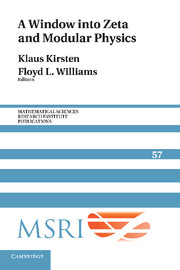Book contents
- Frontmatter
- Contents
- Introduction
- Lectures on zeta functions, L-functions and modular forms with some physical applications
- Basic zeta functions and some applications in physics
- Zeta functions and chaos
- Vertex operators and modular forms
- Applications of elliptic and theta functions to Friedmann–Robertson–Lemaître–Walker cosmology with cosmological constant
- Integrable systems and 2D gravitation: How a soliton illuminates a black hole
- Functional determinants in higher dimensions using contour integrals
- The role of the Patterson–Selberg zeta function of a hyperbolic cylinder in three-dimensional gravity with a negative cosmological constant
Integrable systems and 2D gravitation: How a soliton illuminates a black hole
Published online by Cambridge University Press: 29 May 2025
- Frontmatter
- Contents
- Introduction
- Lectures on zeta functions, L-functions and modular forms with some physical applications
- Basic zeta functions and some applications in physics
- Zeta functions and chaos
- Vertex operators and modular forms
- Applications of elliptic and theta functions to Friedmann–Robertson–Lemaître–Walker cosmology with cosmological constant
- Integrable systems and 2D gravitation: How a soliton illuminates a black hole
- Functional determinants in higher dimensions using contour integrals
- The role of the Patterson–Selberg zeta function of a hyperbolic cylinder in three-dimensional gravity with a negative cosmological constant
Summary
1. Introduction
The interlacing of number theory with modern physics has a long and fruitful history. Indeed, the inital seeds were sown by Riemann himself, from paving the way to the Einstein equations with his introduction of the curvature tensor to setting the stage for quantum correction to black hole entropy with his careful study of the zeta function. This note indicates several elegant connections between two-dimensional gravitation, an eigenvalue problem of interest, extended objects (1D bosonic strings), and zeta regularization in 2D quantum gravity; we also note the presence of modular forms when possible and connect our results to the classical three-dimensional theory. It is our aim to find points of tangency with themes from the 2008 MSRI Summer School on Zeta and Modular Physics and motivate the reader for further exploration.
2. JT Gravitation: A simple 2D metric-scalar field theory
Consider the vacuum Einstein equations with vanishing cosmological constant
where Rij and R denote the Ricci tensor and scalar curvature, respectively, and the solution (Mn, g) is an n-dimensional Riemannian manifold with metric tensor g = gij. A simple calculation shows that for dim M = n = 2, Equation (1) is trivially satisfied. Thus, to make a meaningful interpretation of these field equations, one is compelled to modify the Einstein-Hilbert action from which they arise [40]. Introducing a dilaton a scalar field in the two variables of the manifold, a potential function V = V(y), and a nonzero constant m, the modified action becomes
Standard variational principles yield a corresponding set of field equations
Here, denotes the Hessian of the field computed with respect to the metric gij [9]. The first equation in (3) is referred to as the Einstein equation of the system, with the remainder being called equations of motion for the dilaton. In contrast to (1), solutions to the modified two-dimensional model consist of a metric-dilaton pair.
Information
- Type
- Chapter
- Information
- A Window into Zeta and Modular Physics , pp. 295 - 306Publisher: Cambridge University PressPrint publication year: 2010
